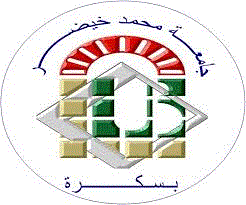| Titre : | Elimination des métaux lourds par complexation-urtrafiltration |
| Auteurs : | Abdelkader Slimani, Auteur ; Djamel Barkat, Directeur de thèse |
| Support: | Mémoire magistere |
| Editeur : | Biskra [Algerie] : Université Mohamed Khider, 2012 |
| Langues: | Français |
| Mots-clés: | Ultrafiltration, Complexation, Cuivre (II), EDTA, Acide citrique, MATLAB. Ultrafiltration, Complexation, Copper (II), EDTA, Citric Acid, Matlab. |
| Résumé : |
L’ultrafiltration est considérée comme un filtre moléculaire bien adapté à la séparation des grosses molécules. Mais elle reste inefficace dans la séparation des cations métalliques à cause de leurs faibles tailles. Pour cela la solution mise en considération pour dépasser cette difficulté était de mettre en œuvre une réaction de complexation avec des macroligands de nature organique afin de pouvoir piéger les ions et les faire retenir par la membrane. Dans ce présent travail on s’intéresse tout particulièrement à la complexation du cuivre (II) avec les deux ligands, EDTA et l’acide citrique. Le but principal de l’étude est l’optimisation des conditions de complexation du métal avec ces deux ligands ; à savoir le pH, la concentration initiale du ligand, la température et la vitesse d’agitation et ceci dans le but d’obtenir les meilleurs rendements de séparation du métal par ultrafiltration. L’étude est passée par deux étapes : La première consiste en une modélisation des deux réactions de complexation. Les résultats obtenus pour une concentration initiale du cuivre [Cu2+] 0=5.10-3 M, ont montré que le complexe Cu-EDTA atteint une concentration maximale et la meilleure stabilité dans le domaine du pH [4-10]. Le complexe Cu-Acide citrique donne quand à lui la meilleure stabilité dans le domaine de pH [3-11]. Le calcul de la constante conditionnelle qui tient compte l’influence des réactions parasites dans le milieu a montré un optimum à pH=6 pour l’EDTA et pH=5 pour l’acide citrique. La deuxième étape est celle de l’étude expérimentale qui montre que les concentrations résiduelles de cuivre diminuent avec l’augmentation de la concentration des agents complexants, avec l’augmentation du pH ainsi qu’avec l’augmentation de la température et la vitesse d’agitation. Les concentrations résiduelles de cuivre obtenues par l’expérience sont : [Cu2+]=2.157 ×10-5 M pour l’EDTA et [Cu2+] = 8.028 ×10-5 M pour l’acide citrique. Les rendements d’ultrafiltration atteints dans le calcul en utilisant les résultats expérimentaux de la complexation sont de R = 99,589 % pour l’EDTA et R= 98,3944 % pour l’acide citrique. The Ultrafiltration is considered as a suitable molecular filter to the separation of the big molecules. But it still inefficient in the separation of the free ions due to their weak sizes. Consequently, the considered solution to overcome the difficulty was the implementation of complexation reactions with organic macroligands in order to trap the ions and to retain them by the membrane. In this work, we are particularly interested by the complexation of Copper (II) with the two ligands EDTA and the Citric Acid. The principal aim of this study is the optimization of the metal complexation conditions with the two ligands , e.i the pH , the initial concentration of the ligand, the temperature and agitation speed , this is in order to obtain the best outcomes of the metal separation by Ultrafiltration. The study was been in two stages: The first consists in the modeling of the two complexation reactions. For the initial concentration of the copper [Cu2+] 0= 5.10-3 M, the obtained results show that the complex Cu-EDTA reaches a maximum concentration and the best stability in the field of pH [4-10], while the complex Cu-Citric acid reaches its maximum in the pH range [3-11]. The calculation of the conditional constant which takes into consideration the influence of parasitic reactions in the field showed an optimum at pH=6 for EDTA and pH=5 for the citric acid. The second stage is the experimental study which mentions that the concentration of the residual copper reduces with the increase of the complexing agents concentration, with the increase of the pH also with the temperature’s increase and agitation speed. For an initial concentration of copper [Cu2+] = 5. 10-3 M. The residual concentrations of copper obtained by the experience are: [Cu2+] = 2.157 × 10-5M for EDTA and [Cu2+] = 8.028 ×10-5 M for the citric acid. The rejection rates of Ultrafiltration achieved in the calculation using the experimental results of the complexation are: R= 99.589% for EDTA and R= 98.3944% for the citric acid. |
Exemplaires (3)
| Cote | Support | Localisation | Disponibilité | Emplacement |
|---|---|---|---|---|
| TH/1430 | Mémoire magistere | Bibliothèque centrale El Allia | Exclu du prêt | Salle de consultation |
| TH/1430 | Mémoire magistere | Bibliothèque centrale El Allia | Exclu du prêt | Salle de consultation |
| TH/1430 | Mémoire magistere | Bibliothèque centrale El Allia | Exclu du prêt | Salle de consultation |
Consulter en ligne (1)
Consulter en ligne URL |



